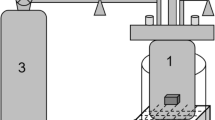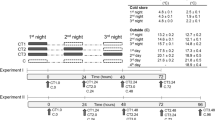Abstract
PREVIOUS investigations1 in our laboratory indicated that treatment of de-fatted, dechlorophyllized leaf tissue with alkali would hydrolyse the RNA into spectrophotometrically measurable nucleotides. Other studies2 showed that RNA was preferentially eluted with 0.12 N hydrochloric acid from a column of ‘Dowex 1–8X’ on which mixtures of RNA and DNA had been adsorbed. This shortened exposure to alkali and recovery of RNA from mixtures of nucleic acid suggested the possibility of direct estimation of RNA in neutralized leaf hydrolysates by passage through a column of Dowex and subsequent elution with 0.12 N hydrochloric acid. Such eluates, however, invariably possessed greater absorption at 260 mμ than comparable material treated according to Diener and Lasheen3. The lower maxima/minima (Mx/Mn) ratios (A260/A234) for the neutralized material indicated that this higher absorbance was due to substances other than RNA. It was found that acidification of these alkaline hydrolysates followed by addition of an equal volume of ethanol and 2 drops of 1.0 M magnesium chloride would precipitate these substances absorbing at 260 mμ. Several portions of the hydrolysates, after removal of the extraneous material by centrifugation, were adjusted to pH's of 5.0, 6.0 or 7.0. Equal volumes of water, alcohol, and alcohol plus 2 drops of magnesium chloride were added to duplicates at each pH and stored for at least 2 h at 2° C. These were then centrifuged to remove the precipitated substances and brought to volume with water and then 10-ml. portions were passed through the column. After washing the column with 5 ml. of double distilled water, the RNA was eluted with 0.12 N hydrochloric acid. The results of a typical experiment are given in Table 1.
This is a preview of subscription content, access via your institution
Access options
Subscribe to this journal
Receive 51 print issues and online access
$199.00 per year
only $3.90 per issue
Buy this article
- Purchase on Springer Link
- Instant access to full article PDF
Prices may be subject to local taxes which are calculated during checkout
Similar content being viewed by others
References
Millikan, D. F., and Pickett, E. E., Nature, 200, 470 (1963).
Zawadzka, B., and Millikan, D. F. (unpublished results).
Diener, T., and Lasheen, A. M., Proc. Amer. Soc. Hort. Sci., 75, 195 (1960).
Reddi, K. K., Biochim. Biophys. Acta, 23, 208 (1957).
Author information
Authors and Affiliations
Rights and permissions
About this article
Cite this article
MILLIKAN, D., PICKETT, E. Some Physical Properties of Interfering Substances associated with the Alkaline Hydrolysis of RNA from Plant Leaf Tissue. Nature 203, 190–191 (1964). https://doi.org/10.1038/203190a0
Issue Date:
DOI: https://doi.org/10.1038/203190a0
Comments
By submitting a comment you agree to abide by our Terms and Community Guidelines. If you find something abusive or that does not comply with our terms or guidelines please flag it as inappropriate.



